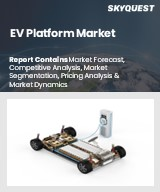
EV 플랫폼 세계 시장 규모는 2023년에 90억 달러로 평가되었으며, 2024년 115억 8,000만 달러에서 2032년에는 871억 9,000만 달러로 성장하여 예측 기간(2025-2032년) 동안 CAGR 28.7%의 성장이 예측됩니다.
전 세계적으로 전기 모빌리티로의 전환은 엄격한 환경 규제, 탄소 배출에 대한 우려, 정부의 막대한 인센티브에 힘입어 전기자동차 플랫폼에 대한 수요가 급증하고 있습니다. 라이드 헤일링 회사와 EV 제조업체 간의 제휴와 같은 전략적 제휴는 지속가능한 모빌리티 솔루션 강화에 대한 약속을 강조하며 이러한 추세를 잘 보여주고 있습니다. 첨단 배터리 기술과 같은 핵심 요소는 이러한 성장에 매우 중요한 역할을 하고 있으며, 자동차의 주행거리와 소비자 수용성에 영향을 미치고 있습니다. 지속가능성이 경쟁 우위로 여겨지고 있는 만큼, 자동차 제조사들은 전기자동차를 도입하는 기업들을 포함하여 환경에 대한 인식이 높아진 소비자들의 요구에 부응하기 위해 전기자동차를 개선해야 할 필요성이 커지고 있습니다. 이러한 소비자 의식의 증가는 정부의 재정 지원 및 EV 기술 혁신과 함께 전기자동차의 견고한 시장을 형성하고 자율주행 기능을 포함한 디자인과 기능의 진보를 촉진하고 있습니다.
Global EV Platform Market size was valued at USD 9.0 billion in 2023 and is poised to grow from USD 11.58 billion in 2024 to USD 87.19 billion by 2032, growing at a CAGR of 28.7% during the forecast period (2025-2032).
The global shift towards electric mobility is being propelled by stringent environmental regulations, heightened concerns about carbon emissions, and significant government incentives, leading to a surging demand for electric vehicle (EV) platforms. Strategic partnerships, such as those between ride-hailing companies and EV manufacturers, exemplify this trend, highlighting commitments to enhance sustainable mobility solutions. Critical elements like advanced battery technology play a pivotal role in this growth, influencing vehicle range and consumer acceptance. Sustainability is increasingly seen as a competitive advantage, prompting automakers to enhance their electric offerings to meet the demands of environmentally-conscious consumers, including businesses adopting electric fleets. This growing consumer awareness, coupled with state funding and innovations in EV technology, is shaping a robust market for electric vehicles and fostering advancements in design and functionality, including autonomous capabilities.
Top-down and bottom-up approaches were used to estimate and validate the size of the Global EV Platform market and to estimate the size of various other dependent submarkets. The research methodology used to estimate the market size includes the following details: The key players in the market were identified through secondary research, and their market shares in the respective regions were determined through primary and secondary research. This entire procedure includes the study of the annual and financial reports of the top market players and extensive interviews for key insights from industry leaders such as CEOs, VPs, directors, and marketing executives. All percentage shares split, and breakdowns were determined using secondary sources and verified through Primary sources. All possible parameters that affect the markets covered in this research study have been accounted for, viewed in extensive detail, verified through primary research, and analyzed to get the final quantitative and qualitative data.
Global EV Platform Market Segments Analysis
Global EV Platform Market is segmented by Vehicle Type, Electric Vehicle Type, Component, Propulsion, Sales Channel and region. Based on Vehicle Type, the market is segmented into Passenger Cars and Commercial Vehicles. Based on Electric Vehicle Type, the market is segmented into Battery Electric Vehicle (BEV) and Plug-in Hybrid Electric Vehicle (PHEV). Based on Component, the market is segmented into Chassis, Battery, Suspension System, Steering System, Drivetrain and Others. Based on Propulsion, the market is segmented into Front-wheel Drive (FWD), Rear-wheel Drive (RWD) and All-wheel Drive (AWD). Based on Sales Channel, the market is segmented into OEMs and Aftermarket. Based on region, the market is segmented into North America, Europe, Asia Pacific, Latin America and Middle East & Africa.
Driver of the Global EV Platform Market
The global Electric Vehicle (EV) Platform market is being significantly driven by various government initiatives aimed at promoting the adoption of electric vehicles. These initiatives include generous subsidies, tax incentives, and regulatory requirements designed to enhance electric mobility. The push for stricter emission standards and commitments to achieving net-zero carbon emissions has further accelerated this transition. A notable instance is the U.S. government's extension of EV tax credits under the Inflation Reduction Act in 2024, which has incentivized automakers to innovate and produce affordable, scalable EV platforms. This collective effort from governments worldwide fosters a conducive environment for the growth of the EV market.
Restraints in the Global EV Platform Market
The Global EV Platform market faces notable constraints stemming from the substantial financial investments required for the development of electric vehicles. The intricacies involved in designing and producing these vehicles necessitate extensive allocation of resources towards research and development (R&D), which is essential for advancing battery efficiency, extending vehicle ranges, and incorporating advanced technologies. Furthermore, the establishment of dedicated production plants, modifications to current manufacturing facilities, and the procurement of vital materials such as lithium and cobalt for battery construction contribute to a significant increase in overall costs, presenting a considerable challenge for automakers in this competitive landscape.
Market Trends of the Global EV Platform Market
The Global EV Platform market is witnessing a significant trend towards the integration of artificial intelligence (AI) and smart technologies, revolutionizing the electric vehicle landscape. As automakers like Tesla and Rivian launch AI-powered features in 2024, the focus on enhancing vehicle autonomy, battery management, and overall user experience intensifies. This transition enables real-time analytics and over-the-air (OTA) software updates, allowing for continuous improvements and increased efficiency. Such advancements not only extend the range of electric vehicles but also redefine consumer expectations, positioning AI-driven innovations as a critical component in the burgeoning EV market amidst growing environmental awareness and technological demand.